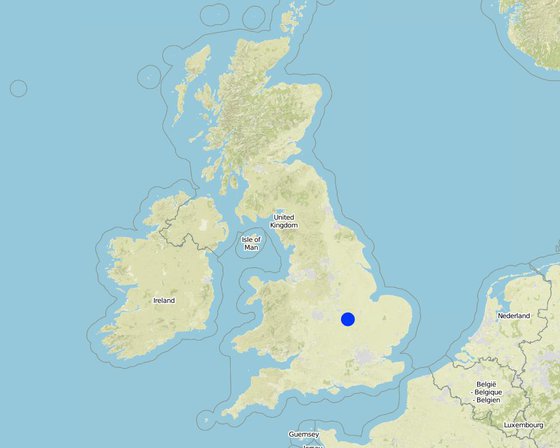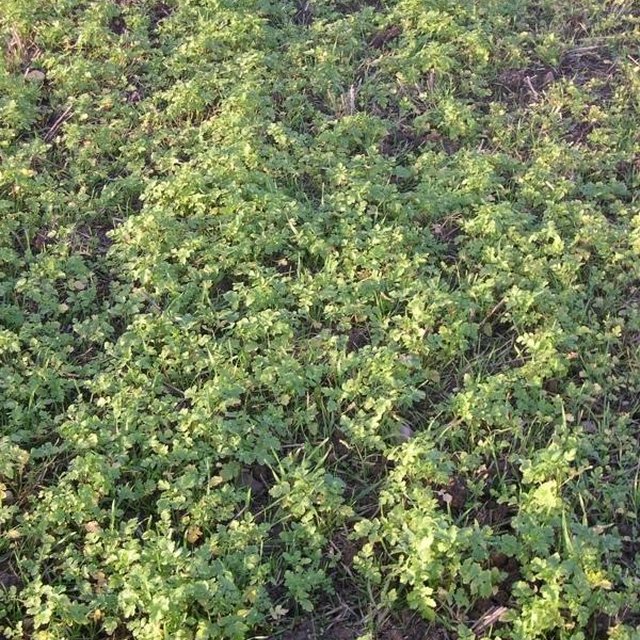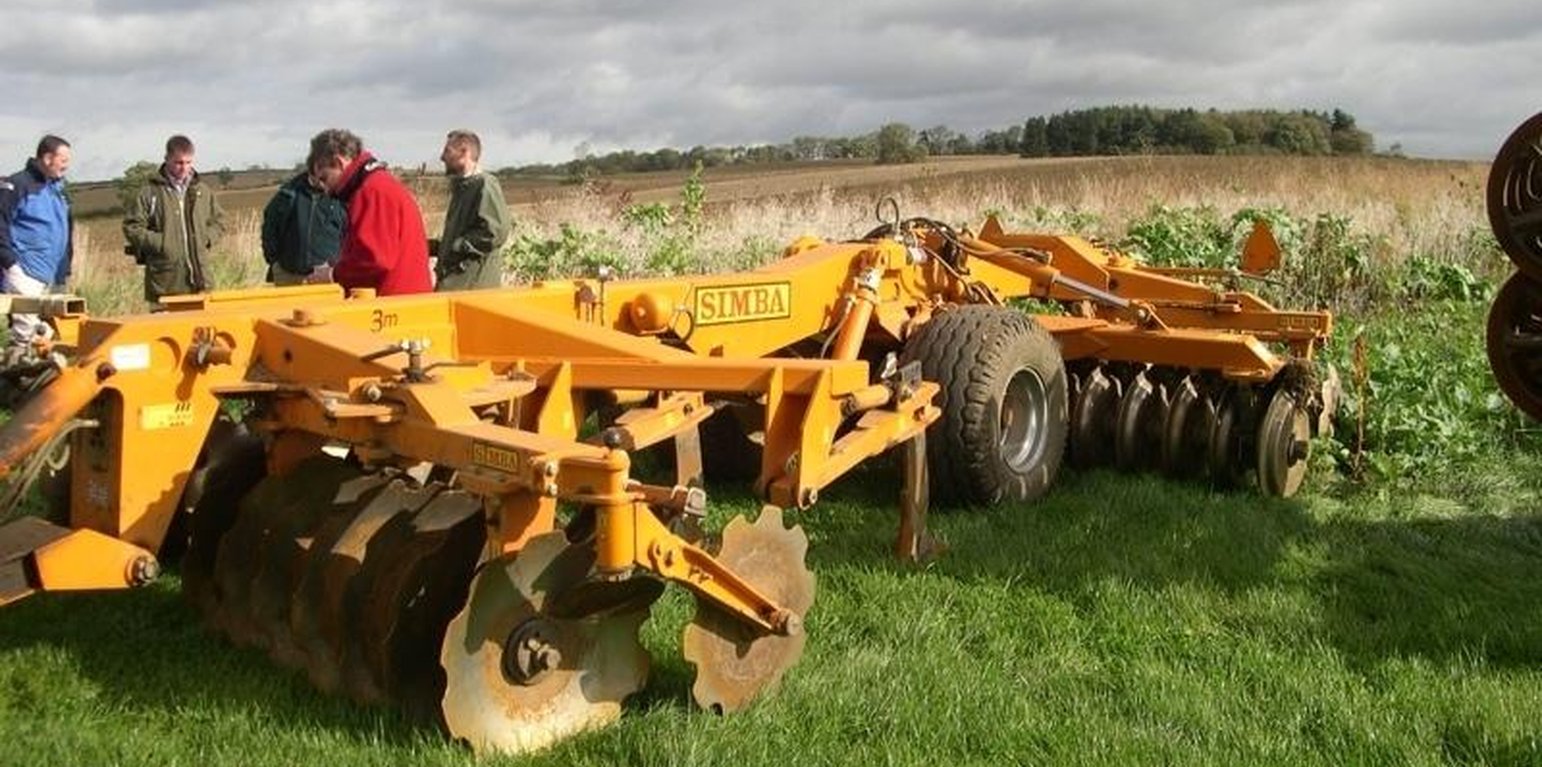Conservation tillage in UK arable cropping: Loddington
(United Kingdom)
minimum tillage (Eng), non-inversion tillage (Engl); no-tillage (Eng); direct drilling (Eng)
Description
Surface cultivation of up to the top 10cm of soil but not complete inversion
machinery with discs or tines replace the plough for minimal cultivations of the soil. Equally crops may be established by no-tillage/ zero-tillage
Purpose of the Technology: (i) soil protection (ii) improved crop establishment particularly through the speeding up of of operations.
Establishment / maintenance activities and inputs: appropriate machinery, soil condition and following crop all determine establishment. Maintenance: on an annual basis.
Natural / human environment: SOWAP (ww.sowap.org) project working with farmer to protect environment and maintain economic viability
Location

Location: Leicestershire, Leicestershire, United Kingdom
No. of Technology sites analysed:
Geo-reference of selected sites
Spread of the Technology:
In a permanently protected area?:
Date of implementation:
Type of introduction
-
through land users' innovation
-
as part of a traditional system (> 50 years)
-
during experiments/ research
-
through projects/ external interventions

Cover crop of mustard and rye
Classification of the Technology
Main purpose
-
improve production
-
reduce, prevent, restore land degradation
-
conserve ecosystem
-
protect a watershed/ downstream areas – in combination with other Technologies
-
preserve/ improve biodiversity
-
reduce risk of disasters
-
adapt to climate change/ extremes and its impacts
-
mitigate climate change and its impacts
-
create beneficial economic impact
-
create beneficial social impact
Land use
-
Cropland
- Annual cropping: cereals - wheat (winter), legumes and pulses - beans, oilseed crops - sunflower, rapeseed, other
Number of growing seasons per year: 1
Water supply
-
rainfed
-
mixed rainfed-irrigated
-
full irrigation
Purpose related to land degradation
-
prevent land degradation
-
reduce land degradation
-
restore/ rehabilitate severely degraded land
-
adapt to land degradation
-
not applicable
Degradation addressed
-
soil erosion by water - Wt: loss of topsoil/ surface erosion, Wo: offsite degradation effects
-
chemical soil deterioration - Cn: fertility decline and reduced organic matter content (not caused by erosion)
-
physical soil deterioration - Pc: compaction
SLM group
-
improved ground/ vegetation cover
-
minimal soil disturbance
SLM measures
-
agronomic measures - A1: Vegetation/ soil cover, A2: Organic matter/ soil fertility, A3: Soil surface treatment (A 3.1: No tillage)
Technical drawing
Technical specifications
Establishment and maintenance: activities, inputs and costs
Calculation of inputs and costs
- Costs are calculated:
- Currency used for cost calculation: UK pounds (£)
- Exchange rate (to USD): 1 USD = 0.56 UK pounds (£)
- Average wage cost of hired labour per day: 155.00
Most important factors affecting the costs
Equipment costs, slope (higher horse power required for steeper slopes), time taken for operation
Establishment activities
n.a.
Maintenance activities
-
Year1: chop straw close to soil surface (Timing/ frequency: harvest / annual)
-
Year1: drill mustard cover crop (Timing/ frequency: after harvest / annual)
-
Year1: incorporate straw and cover crop (Timing/ frequency: September / per crop)
-
Year1: additional cultivation (Timing/ frequency: October / per crop)
-
Year 1: drill crop (4cm depth) (More in Annex 3) (Timing/ frequency: October / once per crop)
Maintenance inputs and costs
| Specify input |
Unit |
Quantity |
Costs per Unit (UK pounds (£)) |
Total costs per input (UK pounds (£)) |
% of costs borne by land users |
|
Labour
|
| drill cover crop (year 1) |
ha |
1.0 |
67.0 |
67.0 |
100.0 |
| drill cover crop (year 2) |
ha |
1.0 |
128.0 |
128.0 |
100.0 |
|
Equipment
|
| Machine use |
ha |
1.0 |
204.0 |
204.0 |
100.0 |
| Machine hours (year 2) |
ha |
1.0 |
67.0 |
67.0 |
100.0 |
| Machine hours (year 3) |
ha |
1.0 |
236.0 |
236.0 |
100.0 |
|
Plant material
|
| Seeds |
ha |
1.0 |
68.0 |
68.0 |
100.0 |
| Seeds (kg) cover crop (year 2) |
ha |
1.0 |
68.0 |
68.0 |
100.0 |
| Total costs for maintenance of the Technology |
838.0 |
|
| Total costs for maintenance of the Technology in USD |
1'496.43 |
|
Natural environment
Average annual rainfall
-
< 250 mm
-
251-500 mm
-
501-750 mm
-
751-1,000 mm
-
1,001-1,500 mm
-
1,501-2,000 mm
-
2,001-3,000 mm
-
3,001-4,000 mm
-
> 4,000 mm
Agro-climatic zone
-
humid
-
sub-humid
-
semi-arid
-
arid
Specifications on climate
Average annual rainfall in mm: 660.0
Slope
-
flat (0-2%)
-
gentle (3-5%)
-
moderate (6-10%)
-
rolling (11-15%)
-
hilly (16-30%)
-
steep (31-60%)
-
very steep (>60%)
Landforms
-
plateau/plains
-
ridges
-
mountain slopes
-
hill slopes
-
footslopes
-
valley floors
Altitude
-
0-100 m a.s.l.
-
101-500 m a.s.l.
-
501-1,000 m a.s.l.
-
1,001-1,500 m a.s.l.
-
1,501-2,000 m a.s.l.
-
2,001-2,500 m a.s.l.
-
2,501-3,000 m a.s.l.
-
3,001-4,000 m a.s.l.
-
> 4,000 m a.s.l.
Technology is applied in
-
convex situations
-
concave situations
-
not relevant
Soil depth
-
very shallow (0-20 cm)
-
shallow (21-50 cm)
-
moderately deep (51-80 cm)
-
deep (81-120 cm)
-
very deep (> 120 cm)
Soil texture (topsoil)
-
coarse/ light (sandy)
-
medium (loamy, silty)
-
fine/ heavy (clay)
Soil texture (> 20 cm below surface)
-
coarse/ light (sandy)
-
medium (loamy, silty)
-
fine/ heavy (clay)
Topsoil organic matter content
-
high (>3%)
-
medium (1-3%)
-
low (<1%)
Groundwater table
-
on surface
-
< 5 m
-
5-50 m
-
> 50 m
Availability of surface water
-
excess
-
good
-
medium
-
poor/ none
Water quality (untreated)
-
good drinking water
-
poor drinking water (treatment required)
-
for agricultural use only (irrigation)
-
unusable
Is salinity a problem?
Occurrence of flooding
Characteristics of land users applying the Technology
Market orientation
-
subsistence (self-supply)
-
mixed (subsistence/ commercial)
-
commercial/ market
Off-farm income
-
less than 10% of all income
-
10-50% of all income
-
> 50% of all income
Relative level of wealth
-
very poor
-
poor
-
average
-
rich
-
very rich
Level of mechanization
-
manual work
-
animal traction
-
mechanized/ motorized
Sedentary or nomadic
-
Sedentary
-
Semi-nomadic
-
Nomadic
Individuals or groups
-
individual/ household
-
groups/ community
-
cooperative
-
employee (company, government)
Age
-
children
-
youth
-
middle-aged
-
elderly
Area used per household
-
< 0.5 ha
-
0.5-1 ha
-
1-2 ha
-
2-5 ha
-
5-15 ha
-
15-50 ha
-
50-100 ha
-
100-500 ha
-
500-1,000 ha
-
1,000-10,000 ha
-
> 10,000 ha
Scale
-
small-scale
-
medium-scale
-
large-scale
Land ownership
-
state
-
company
-
communal/ village
-
group
-
individual, not titled
-
individual, titled
-
Trust
Land use rights
-
open access (unorganized)
-
communal (organized)
-
leased
-
individual
-
Trust
Water use rights
-
open access (unorganized)
-
communal (organized)
-
leased
-
individual
-
Trust
Access to services and infrastructure
Impacts
Socio-economic impacts
farm income
Uncertain after only 3 years
Socio-cultural impacts
Impression of the technology
Land manager enthusiastic about the technology
Ecological impacts
soil cover
Residue and/or cover crop
soil loss
Quantity before SLM: 0.01
Quantity after SLM: 0
animal diversity
Higher earthworm populations, improved soil microbiology
Input constraints
Better range of herbicide options
Cost of cover crop seed
Can negate the cost savings achieved through the lower crop establishment costs
Soil erosion locally
Immediately after drilling cover crop
Off-site impacts
groundwater/ river pollution
Cost-benefit analysis
Benefits compared with establishment costs
Short-term returns
very negative
very positive
Long-term returns
very negative
very positive
Benefits compared with maintenance costs
Short-term returns
very negative
very positive
Long-term returns
very negative
very positive
Adoption and adaptation
Percentage of land users in the area who have adopted the Technology
-
single cases/ experimental
-
1-10%
-
11-50%
-
> 50%
Of all those who have adopted the Technology, how many have done so without receiving material incentives?
-
0-10%
-
11-50%
-
51-90%
-
91-100%
Has the Technology been modified recently to adapt to changing conditions?
To which changing conditions?
-
climatic change/ extremes
-
changing markets
-
labour availability (e.g. due to migration)
Conclusions and lessons learnt
Strengths: land user's view
-
timeliness
How can they be sustained / enhanced? good planning
-
improved biodiversity
-
improved soil organic matter
Strengths: compiler’s or other key resource person’s view
-
cost effectiveness
How can they be sustained / enhanced? increase are under cultivation (economy of scale)
-
improved soil quality
How can they be sustained / enhanced? continuing practice; retention of straw
-
increased soil biodiversity
-
improved water quality
-
increased work rate
Weaknesses/ disadvantages/ risks: land user's viewhow to overcome
Weaknesses/ disadvantages/ risks: compiler’s or other key resource person’s viewhow to overcome
-
potential for increased weed populations
improved rotations, greater use of cover crops to compete with weeds
-
cost of cover crop seed and lack of appropriate species
greater use will encourage lower cost and more speciesw research
References
Reviewer
-
Fabian Ottiger
-
Alexandra Gavilano
Date of documentation: Feb. 24, 2011
Last update: Aug. 22, 2019
Resource persons
-
Ceris A. Jones - SLM specialist
-
Alastaire Leake - SLM specialist
Full description in the WOCAT database
Documentation was faciliated by
Institution
- Game & Wildlife Conservation Trust - United Kingdom
Project
- Soil and water protection (EU-SOWAP)










